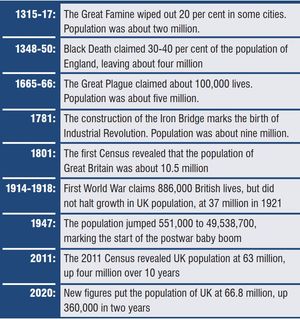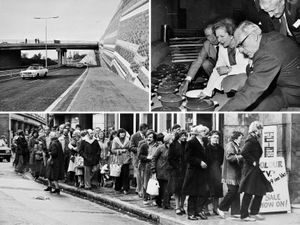From the Black Death to Maastricht: How UK population has changed
In 1800, the Russian Empire was home to 35 million people. The United States, then a somewhat backward agrarian society, had a population of 5.3 million. Great Britain, as opposed to the wider British Empire, was home to 10.5 million inhabitants. Even British India, one of the largest nations in the world, had a population of just 40 million.
This week, new figures from the Office for National Statistics revealed that the UK population grew to a record 66.8 million last year, meaning that there are almost twice as many people crowded into this small island today as the vast expanse of Russia at the turn of the 19th century.
The figures actually show a slowing of the growth rate. The UK population grew by 361,000 over the 12 months to the middle of last year, or 0.5 per cent. This is the lowest rise for 15 years, but nevertheless shows a country with a population density that would never have been envisaged even a century ago.
The earliest reliable record of Britain's population can be found in the Domesday Book of 1086, which found there were just over 1.7 million across the Norman-held counties of England and Mid Wales.
Over the next century the population saw rapid growth, rising by 81 per cent to 3.1 million by 1190. The trend continued over the next 30 years, reaching 3.97 million by 1220.

Of course, these early figures need to be treated with considerable caution, particularly given the fluid state of the boundaries between the different kingdoms at this time. But as a general rule, it seems that the population increased steadily to something like seven million by the start of the 14th century, when the Great Famine marked the start of a series of events that would reverse that trend.
The beginning of the 14th century was marked by a series of localised famines across Europe, with France among those badly hit. But England had managed to avoid them until unusually heavy rainfall came during the spring of 1315.
The wet weather continued across most of Europe throughout the spring and summer, and temperatures also remained unseasonably cool. Grain did not ripen, leading to widespread crop failures, while straw and hay for animals could not be cured, creating a shortage of meat. There was also a shortage of salt, needed to cure and preserve meat, and these factors all contributed to the doubling of food prices between spring and midsummer. Even King Edward II suffered; when he stopped at St Albans on August 10, 1315, his entourage struggled to find bread, leaving him unable to eat. The weather returned to normal during the summer of 1317, but by then the damage had been done. The famine left people weakened by diseases including pneumonia, bronchitis, and tuberculosis, and so much of the seed stock had been eaten that food supplies would not return to normal until 1325. The death toll of the Great Famine has been hotly debated, but it is likely that many towns and cities would have seen between 10 and 25 per cent of their populations wiped out.
But that was just the beginning. In June 1348 the Black Death, the first manifestation of a plague that would wipe out half of Europe and Asia, arrived on the British mainland. It is believed that the bubonic plague pandemic began in Mongolia in 1346, spreading westwards across Europe. The first recorded case on the British mainland was in Weymouth, when a sailor arrived from the then British province of Gascony. Within a year it had spread across the whole country, and it continued to spread until the winter of 1349-50 largely killed it off. Estimates of the death toll vary wildly, with some putting the figure as high as 90 per cent of he population. Realistically, the population of England at that time probably stood at around six million, and in the region of 30-40 per cent would have been killed as a result of the illness.

But while the first, and worst outbreak was over in a couple of years, the plague didn't go away. Indeed the next 300 years became known as the 'Plague Centuries', with sporadic outbreaks until the Great Plague of London in 1665-66.
From the Black Death to the mid-1500s, the population of England showed a slow decline, flatlining at about the three million mark before starting to rise in the late 16th century.
But it was the Industrial Revolution, beginning with the opening of the Iron Bridge in 1781, which saw a population explosion, largely sparked by an increase in life expectancy. While social historians often portray the 19th century as an era of the haves and have-nots, with the working classes living in grinding poverty and squalid housing, the reality is that this was a vast improvement compared to what went before.
The first modern-day census of 1801 reported there were 10.5 million people living in the UK, but by 1901 this had grown to 37.8 million. This happened despite a sharp drop in the fertility rate: in 1800, the average woman would give birth to 4.97 children during her lifetime, falling to 3.58 by the end of the century. However, while the birth rate was falling, life expectancy grew considerably during the 19th century. In 1543, life expectancy stood at 33.9 in 1543, reaching 40 by 1803. But over the next 100 years this would rise to 49.5, driving the growth in population.

This trend continued throughout the 20th century, with life expectancy passing 50 in 1907, and reaching 60.8 by 1930.
The First World War cost 886,000 British lives, but this was not enough to stop the inexorable growth in population, which had reached 41 million by the outbreak of the Second World War.
By this time the fertility rate had fallen to 1.84, but life expectancy had grown to 63.6.
The return of servicemen at the end of the Second World War sparked a dramatic spike in the fertility rate, rising to 2.47 in 1946, and 2.69 the following year, marking the beginning of the postwar baby boom. The number of births broke the million mark in 1947, for the first time since 1921, a feat which was repeated in 1964, when the fertility rate peaked at 2.95. The 20th century also saw great strides in medicine, which helped life expectancy grow to 71 by 1965.
By 1972, the population had reached 56 million, a level at which it would plateau for more than a decade. But 1983 saw the number migrants entering the UK exceed those leaving for the first time since 1964, a trend which – apart from a couple of blips – has continued ever since. The Maastricht Treaty of 1993 guaranteed freedom of movement for all member states in the newly formed European Union, and saw net migration peak at 268,000 in 2004, taking the UK population to almost 60 million. Positive net migration has continued ever since, although it did fall back a little to 177,000 in 2012, before rising again to 332,000 in 2015.





